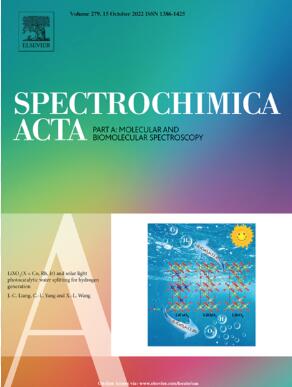Molecular level inelastic electron tunneling spectroscopy of protoporphyrin using scanning tunneling microscope
IF 4.3
2区 化学
Q1 SPECTROSCOPY
Spectrochimica Acta Part A: Molecular and Biomolecular Spectroscopy
Pub Date : 2025-03-28
DOI:10.1016/j.saa.2025.126126
引用次数: 0
Abstract
Protoporphyrin IX (PPIX) is a crucial biomarker for tumor recurrence and to detect glioma at an early stage. Conventional optical detection methods for PPIX lack molecular-level sensitivity due to interference from its fluorescence. Inelastic electron tunneling spectroscopy (IETS) can be used as a probing technique to develop a hyper-sensitive biosensor for PPIX. We employ a scanning tunneling microscope (STM) to investigate the vibrational levels of single molecules at room temperature. The IETS-STM measurements of PPIX on highly oriented pyrolytic graphite (HOPG) showed the self-assembly of the molecules with a molecular array spacing of 1.71 ± 0.02 nm, and the spectra exhibited distinguishable peaks even at elevated temperatures. Analysis of peak broadening around 400 cm−1 conducted at temperatures ranging from 77 K to 300 K showed deviation from the expected theoretical limit of thermal broadening. The impact of temperature and voltage on tunneling electrons were also analyzed to gain insight into the drift of the electrons through PPIX molecules.

求助全文
约1分钟内获得全文
求助全文
来源期刊
CiteScore
8.40
自引率
11.40%
发文量
1364
审稿时长
40 days
期刊介绍:
Spectrochimica Acta, Part A: Molecular and Biomolecular Spectroscopy (SAA) is an interdisciplinary journal which spans from basic to applied aspects of optical spectroscopy in chemistry, medicine, biology, and materials science.
The journal publishes original scientific papers that feature high-quality spectroscopic data and analysis. From the broad range of optical spectroscopies, the emphasis is on electronic, vibrational or rotational spectra of molecules, rather than on spectroscopy based on magnetic moments.
Criteria for publication in SAA are novelty, uniqueness, and outstanding quality. Routine applications of spectroscopic techniques and computational methods are not appropriate.
Topics of particular interest of Spectrochimica Acta Part A include, but are not limited to:
Spectroscopy and dynamics of bioanalytical, biomedical, environmental, and atmospheric sciences,
Novel experimental techniques or instrumentation for molecular spectroscopy,
Novel theoretical and computational methods,
Novel applications in photochemistry and photobiology,
Novel interpretational approaches as well as advances in data analysis based on electronic or vibrational spectroscopy.

 求助内容:
求助内容: 应助结果提醒方式:
应助结果提醒方式:


